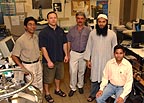September 14, 2006
Research may lead to solid-state refrigeration
CARBONDALE, Ill. -- Research at Southern Illinois University Carbondale may revolutionize refrigeration.
Naushad Ali, professor of physics, and Shane Stadler, assistant professor of physics, recently received a four-year grant worth $623,000 from the U.S. Department of Energy to continue their work on metal alloys that have colossal magnetocaloric properties. The term refers to metal combinations that have the ability to heat up and cool down rapidly and to below ambient temperatures when placed in a magnetic field.
Here's an analogy: If you stretch a rubber band, it heats up. Let it cool off and remove the tension and it will cool down to a temperature lower than it was before you stretched it.
The scientists' research is aimed at creating solid-state refrigeration that uses magnetism that, in effect, works like the tension and release forces exerted on the rubber band. The method might someday take the place of traditional refrigeration systems that use compressed gasses such as Freon to remove heat from objects.
During a previous set of experiments, the pair, assisted by graduate student Mahmud Khan and others, examined different alloys that change shape in a magnetic field. It was then they discovered the magnetic cooling effect of a specific alloy that has excellent potential for making solid-state refrigeration a reality.
"Often times that's how it works when you're doing research," said Ali, who recently celebrated his 20th year at SIUC. "It was not the original objective. We are scientists, not engineers and we happened to find this effect, and it became more interesting in terms of funding because this is a new field."
In these particular metal alloys, the temperature at which the substance changes its physical structure and the temperature at which it loses its magnetic properties typically are far apart. Under such circumstance, significant magnetic cooling — the colossal magnetocaloric effect — is absent.
Ali and Stadler, however, continued experimenting with differing alloys, changing the quantities of metals involved to "tune" the alloys to the properties they were seeking. About 18 months ago, they created an alloy — a form of nickel-manganese-copper-gallium —that changes its structure and loses magnetic properties at almost identical temperatures, both of which are around room temperature.
"We have brought these temperatures to one place," Ali said. "When this happens, the refrigeration effect is the largest."
Composed of common materials and easily fabricated, the promising alloy is unlike many others used in prototype solid-state or magnetic refrigeration devices.
A solid-state refrigeration unit would be a far simpler item than traditional cooling machines. It would rely on far fewer moving parts, making it more efficient and easier to maintain. The metals used also are generally nontoxic and far more environmentally friendly than traditional units that rely on compressed gases such as Freon, which has been shown to damage ozone in the atmosphere.
The grant will pay for a full-time researcher, graduate and undergraduate student workers, material and testing facilities.
Understanding why this particular metal combination displays such properties is an important step forward in taking the magnetocaloric effect out of the laboratory and into the marketplace, Stadler said.
"If we understand why it happens on an atomic level we can fabricate new materials or improve the performance of these,' Stadler said. "This could lead to a revolution in solid-state refrigeration. Your refrigerator and air conditioning could be replaced by this system."
Ali also recently received a $50,000 grant from the Research Corp., a private non-profit organization, for additional research on the magnetocaloric effect. The University matched that grant with $25,000.
Identifying, pursuing and obtaining new sources of external grant and contract funding and leading in research, scholarly and creative activities are among the goals of Southern at 150: Building Excellence Through Commitment, the blueprint the University is following as it approaches its 150th anniversary in 2019.

ool team – A team in the Department
of Physics in the College of
Science at Southern Illinois
University Carbondale recently
received a four-year grant worth
$623,000 from the U.S. Department
of Energy to continue their work
on metal alloys that could
revolutionize refrigeration.
The team, from left, is Naushad
Ali, professor of physics, Shane
Stadler, assistant professor of
physics, Igor Dubenko, visiting
researcher, Mahmud Khan,
doctoral student in applied
physics and Arjun Pathak,
graduate student in physics.
Download Photo Here
